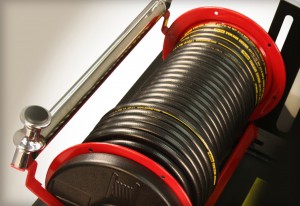 Print a Sign-In Sheet | Spanish Version Coming Soon
Print a Sign-In Sheet | Spanish Version Coming Soon
- Provide steam hose operators with adequate safety gear, including gloves, rubber boots, full-length protective clothing, and eye protection. The objective is to protect the operator from scalding burns that may result from splash back of steam or hot water.
- Ensure the work area is free of tripping hazards and other clutter.
- Check the tightness of the coupling with each use.
- Do not allow a hose to remain pressurized when not in service. Turning off the pressure can dramatically increase the service life of a hose.
- Ensure periodic maintenance of steam hoses. All steam hoses are expected to wear out in time. It is important to continually be on the lookout for hoses that are unsafe because of deterioration.
- Operators should be aware of obvious signs of trouble, including:
- Cover blisters or lumps.
- Cuts or gouges in the outside of the hose that expose the reinforcement.
- Hardened or inflexible hose.
- Steam leakages at the coupling ends or anywhere along the length of the hose.
- Flattened or kinked areas that have damaged the hose.
- A reduction of steam flow, indicating that the tube is swelling.
When any of these abnormalities are present, it is good safety sense to immediately remove the hose from service. Once removed, the hose can be carefully inspected before further use. Flexing and strain at the couplings may cause steam hoses to fail near the ends of the hose. In those cases, the hose can frequently be cut back and recoupled, providing additional service life. Hoses used in continuous high-pressure/ temperature service should be inspected periodically for signs of tube hardening. In most cases, it is necessary to remove a coupling for tube inspection.
KEMI does not assume liability for the content of information contained herein. Safety and health remain your responsibility. This information is to be used for informational purposes only and not intended to be exhaustive or a substitute for proper training, supervision, or manufacturers’ instructions/recommendations. KEMI, by publication of this information, does not assume liability for damage or injury arising from reliance upon it. Compliance with this information is not a guarantee or warranty that you will be in conformity with any laws or regulations nor does it ensure the absolute safety of any person, place, or object, including, but not limited to, you, your occupation, employees, customers, or place of business.

